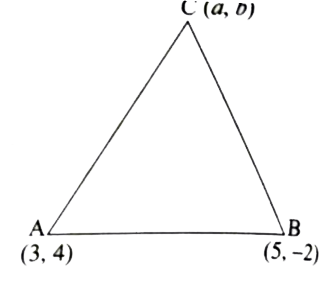the point A,B,C have respective coordinates (3,4),(-4,3) and (8,-6) . Find the area of ΔABC and the length of the perpendicular from A on ¯¯¯¯¯¯BC.Solution in Bengali
The correct Answer is:12.15.p=752or,p=5
Step by step video, text & image solution for the point A,B,C have respective coordinates (3,4),(-4,3) and (8,-6) . Find the area of DeltaABC and the length of the perpendicular from A on overline(BC). by Maths experts to help you in doubts & scoring excellent marks in Class 12 exams.
Updated on:21/07/2023Topper's Solved these Questions
- REVISION OF PREVIOUS TWO DIMENSIONAL COORDINATE GEOMETRY Book:CHHAYA PUBLICATIONChapter:REVISION OF PREVIOUS TWO DIMENSIONAL COORDINATE GEOMETRY Exercise:EXERCISE 1 (MCQ)
Explore 30 Videos
- REVISION OF PREVIOUS TWO DIMENSIONAL COORDINATE GEOMETRY Book:CHHAYA PUBLICATIONChapter:REVISION OF PREVIOUS TWO DIMENSIONAL COORDINATE GEOMETRY Exercise:EXERCISE 1 (Very Short Type Questions )
Explore 41 Videos
- RELATIONSBook:CHHAYA PUBLICATIONChapter:RELATIONSExercise:Sample Question for Competitive Examination (Assertion -Reason Type )
Explore 2 Videos
- SECOND ORDER DERIVATIVEBook:CHHAYA PUBLICATIONChapter:SECOND ORDER DERIVATIVEExercise:Sample Question for Competitive Examination (Assertion-Reason type)
Explore 2 Videos
Similar Questions
The abscissa of any point on y -axis is -
View SolutionThe sides of the rectangle ABCD are parallel to the coordinate axis. If the coordinates of the vertices B and D be (7,3) and (2,6) respectively, find the coordinates of the vertices A and C .
View SolutionEach question in this section has four choices A , B, C , and D out of which only one is coR Rect. Mark your choices as follows .
Let R be a relation on the set NN of the natural numbers defined by nRm <⇒ n is a factor of m.
Statement -1 : R is not oan equivalence relation.
Statement -II: R is not symmetric
View SolutionGiven, x2+y2=1. Y' and y'' are first and second order derivative of y respectively.
Statement-I 1+yy''+(y')2=0
Statement- II xx'+2y=0
View SolutionIf the coordinates of the points A, B, C, D be (1,2,3), (4,5,7), (4,3,6)and (2,9,2)respectively, then find the angle between the lines AB and CD.
View SolutionThe vertices of a triangle are A(3,4),B(-4,3),C(4,3). The altitude from A on BC meets the circumcircle at
View SolutionFind the area of the triangle whose vertices A, B, C are (3,4),(−4,3),(8,6) respectively and hence find the length of perpendicular from A to BC.
View SolutionIf the coordinates of the points A,B,C,Dbe91,2,3),(4,5,7),(−4,3,−6)and(2,9,2) respectively then find the angle between AB and CD.
View Solutionउस त्रिभुज का क्षेत्रफल ज्ञात करे जिसके शीर्ष क्रमश : (3,4),(−4,3) और (8,−6) है |
View Solutionउस त्रिभुज का क्षेत्रफल ज्ञात कोजिए जिसके शीर्ष A, B, C क्रमश: (3,4), (-4, 3), (8, 6) हें । साथ ही A से BC पर डाले गये लम्ब की लाबाई भी ज्ञात करें ।
View SolutionThe vertices A,B and C of ΔABC have coordinates (-3,-2),(2,-2) and (6,1) respectively . Find the area of the ΔABC and the length of the perpendicular from A on ¯¯¯¯¯¯BC.
View SolutionA(-1,5),B(3,1)and C(5,7) are the vertices of the ΔABC. If D ,E and F are the mid - points of the sides ¯¯¯¯¯¯BC,¯¯¯¯¯¯CAand¯¯¯¯¯¯AB respectively , find the area of ΔDEF. Show also that , ΔABC=4ΔDEF.
View SolutionThe coordinates of the points A and B are (3,4) and (5,-2) respectively , if ¯¯¯¯¯¯PA=¯¯¯¯¯¯PB and the area of the ΔPAB=10 square unit , find the coordinates of P.
View SolutionThe coordinates of A, B and C are (3,4), (-4,3) and (8,-6) respectively , Find the area of the ΔABC and also find the perpendicular distance of BC from the vertex A.
View SolutionIf the coordinates of two points A and B are (3,4) and (5,-2) respectively . Find the coordinates of any point 'c' , if AC =BC and area of triangle ABC =10 sq. units.

View Solution

